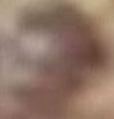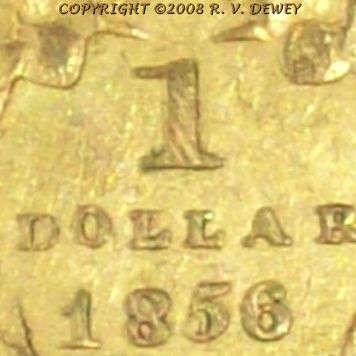
PREV ARTICLE
NEXT ARTICLE
FULL ISSUE
PREV FULL ISSUE
V11 2008 INDEX
E-SYLUM ARCHIVE
MORE ON SECRET ARTIST SIGNATURES
Responses concerning R.V. Dewey's image of what he says is
a secret James Longacre signature on a coin are still coming in slowly.
-Editor
Joe Levine writes:
 I, too see the face of a mustachioed man with curly
black hair on the right. On the left, however, I see a skull with sunken
eyes. These are as clear to me as my own image I saw this morning at
breakfast on the left lower quadrant of a piece of whole wheat toast!
I, too see the face of a mustachioed man with curly
black hair on the right. On the left, however, I see a skull with sunken
eyes. These are as clear to me as my own image I saw this morning at
breakfast on the left lower quadrant of a piece of whole wheat toast!
Bill Eckberg writes:
On the secret Longacre signature, I admit that I can't
see much in the enlarged images presented. Maybe a primitive, cartoon-like
face on the right, but it would need to be sharper to be
convincing.
 Cartoon signatures are not unprecedented for the
era. James McNeil Whistler transformed his JW monogram into the famous
"Butterfly" signature, which actually does not represent a butterfly at
all, but is a cartoon self-portrait of the upper part of his own face.
Cartoon signatures are not unprecedented for the
era. James McNeil Whistler transformed his JW monogram into the famous
"Butterfly" signature, which actually does not represent a butterfly at
all, but is a cartoon self-portrait of the upper part of his own face.
The dark areas are his hair and eyebrows, and in the 1883 and 1885 iterations on the linked page, he even includes the white forelock of which he was so proud. As far as I know, he signed all of the etchings that he, personally, printed with one form or another of the "Butterfly".
 Cartoon signatures are not unprecedented for the
era. James McNeil Whistler transformed his JW monogram into the famous
"Butterfly" signature, which actually does not represent a butterfly at
all, but is a cartoon self-portrait of the upper part of his own face.
Cartoon signatures are not unprecedented for the
era. James McNeil Whistler transformed his JW monogram into the famous
"Butterfly" signature, which actually does not represent a butterfly at
all, but is a cartoon self-portrait of the upper part of his own face.
The dark areas are his hair and eyebrows, and in the 1883 and 1885 iterations on the linked page, he even includes the white forelock of which he was so proud. As far as I know, he signed all of the etchings that he, personally, printed with one form or another of the "Butterfly".
To read the complete article, see: A chronology of Whistler's butterfly signatures (http://www.whistler.arts.gla.ac.uk/HTML/Butter.htm)
This week R.V. forwarded a more conventional coin photo, this one of a pattern, an 1856 Gilt/Brass $1 Gold Dollar with what he terms a .Hand Stamped Date. He writes:
The enclosed photograph of the 1856 $1 Gold Dollar with
the irregularly spaced and rising .hand stamped. date is (SEM-EDX) 55% Au,
Gold .Gilt., Brass: 84% Cu/16% Zn. Exactly 5% difference, (80%Cu/20%Zn) in
copper content than my earlier (SEM-EDX) tested 1851 Orichalchum Gold
Dollar.! Please note the known .tested. 1849 gold dollar discussed on
USPatterns.com website is 51% gold, and most likely gilt because of the
very, very low weight!

Regardless gilt or solid, my coin is amazingly within 1Kt. gold of that coin (seven years apart one pattern is 12.24Kt. the other; 13.20Kt), 157 year old coincidence? If either coin was meant to deceive someone, they would have been made with 21.5Kt. or 90% gold content, not the 51% and 55% respectively that we see on these two known coins.
A lone 12Kt. or 13Kt. gold coin set on a table with a pile of, .coin of the realm., 90% gold coins could get one shot. The color of the gold from the .known. low gold content tells everyone that these coins were not intended for commerce!
Someone has drawn numerous tiny oblique parallel lines on the numeral 1 above the word dollar and somehow managed to stay within the lines. For lack of a better term; notice the unique .Pinocchio. nose of the numeral 1 extending far to the left, unlike the production gold dollar coins of 1856. Did I mention there are faces in each upper corner?
This Gilt dollar is extremely rare, if not unique! Quite possibly the first .Large Head.! On this day JBL was obviously experimenting with a Brass planchet instead of gold. I am told that, .brass was not really used in the Mint to strike coinage at that time.. I believe more accurately, brass was not known to be used for the tinniest of all United States coins, at that time. Quite possibly the date was hand stamped because an 1856 die did not exist at the .needed. time, since the 1856 Obverse of the $1 Gold Dollar was in a transitional stage. Third time is the charm, and the only change on the reverse would have been the .date. that we see haphazardly stamped on this coin and rising noticeably upward to the right!
After viewing a picture of the Gilt/Brass 1856 gold dollar, Mr. Saul Teichman wrote the following on August 20th 2008: .The 1856 looks like it was a handmade die.. Is it noticeably different than the other 1856 gold dollars? See for yourself, is it unique? What do we really have here? A .one-time. counterfeiter who wants to get caught, shot or jailed, by tediously making 13Kt. .handmade looking. gold coins from scratch, instead of simply and quickly copying an existing 1856 coin.
Perhaps, more likely, we have a previously unknown JBL pattern, trial, or experimental piece? If one believes all the pattern books available, an 1856 $1 Gold Dollar pattern does not exist, period. Do numismatic scholars believe Mr. Longacre decided not to make any $1 Gold Dollar patterns in 1856 or is it more reasonable to believe that not one has yet been found?
It would seem Mr. Longacre forgot to leave us the definitive periodical for identifying 19th Century patterns. For example, it could have been called: My Mint Pattern Coins for Sale, unfortunately we all know JBL did not write that incriminating book. What we should all remember is that history records that he did get caught signing his coins from time to time. How will we identify these forgotten patterns? Consider the following rhetorical questions:

Regardless gilt or solid, my coin is amazingly within 1Kt. gold of that coin (seven years apart one pattern is 12.24Kt. the other; 13.20Kt), 157 year old coincidence? If either coin was meant to deceive someone, they would have been made with 21.5Kt. or 90% gold content, not the 51% and 55% respectively that we see on these two known coins.
A lone 12Kt. or 13Kt. gold coin set on a table with a pile of, .coin of the realm., 90% gold coins could get one shot. The color of the gold from the .known. low gold content tells everyone that these coins were not intended for commerce!
Someone has drawn numerous tiny oblique parallel lines on the numeral 1 above the word dollar and somehow managed to stay within the lines. For lack of a better term; notice the unique .Pinocchio. nose of the numeral 1 extending far to the left, unlike the production gold dollar coins of 1856. Did I mention there are faces in each upper corner?
This Gilt dollar is extremely rare, if not unique! Quite possibly the first .Large Head.! On this day JBL was obviously experimenting with a Brass planchet instead of gold. I am told that, .brass was not really used in the Mint to strike coinage at that time.. I believe more accurately, brass was not known to be used for the tinniest of all United States coins, at that time. Quite possibly the date was hand stamped because an 1856 die did not exist at the .needed. time, since the 1856 Obverse of the $1 Gold Dollar was in a transitional stage. Third time is the charm, and the only change on the reverse would have been the .date. that we see haphazardly stamped on this coin and rising noticeably upward to the right!
After viewing a picture of the Gilt/Brass 1856 gold dollar, Mr. Saul Teichman wrote the following on August 20th 2008: .The 1856 looks like it was a handmade die.. Is it noticeably different than the other 1856 gold dollars? See for yourself, is it unique? What do we really have here? A .one-time. counterfeiter who wants to get caught, shot or jailed, by tediously making 13Kt. .handmade looking. gold coins from scratch, instead of simply and quickly copying an existing 1856 coin.
Perhaps, more likely, we have a previously unknown JBL pattern, trial, or experimental piece? If one believes all the pattern books available, an 1856 $1 Gold Dollar pattern does not exist, period. Do numismatic scholars believe Mr. Longacre decided not to make any $1 Gold Dollar patterns in 1856 or is it more reasonable to believe that not one has yet been found?
It would seem Mr. Longacre forgot to leave us the definitive periodical for identifying 19th Century patterns. For example, it could have been called: My Mint Pattern Coins for Sale, unfortunately we all know JBL did not write that incriminating book. What we should all remember is that history records that he did get caught signing his coins from time to time. How will we identify these forgotten patterns? Consider the following rhetorical questions:
- Is every pattern coin a perfect specimen?
- Should less then perfect patterns be dismissed?
- Are there no more patterns to be discovered?
- Has every pattern now been accounted for?
- Will the missing patterns remain forever missing since we lack a written account from JBL?
I'm not well versed in U.S. pattern coinage, but I think
what R.V. is saying is that this 1856 gold dollar is a genuine U.S. Mint
product, and that it is distinctly different from either the regular
issues or any known patterns, and thus must be a pattern
itself.
Take a close look at the upper-right-hand corner of the photo. Do you see anything unusual? -Editor
Take a close look at the upper-right-hand corner of the photo. Do you see anything unusual? -Editor

Wayne Homren, Editor
The Numismatic Bibliomania Society is a non-profit organization promoting numismatic literature. See our web site at coinbooks.org.
To submit items for publication in The E-Sylum, write to the Editor at this address: whomren@gmail.com
To subscribe go to: https://my.binhost.com/lists/listinfo/esylum
All Rights Reserved.
NBS Home Page
Contact the NBS webmaster
